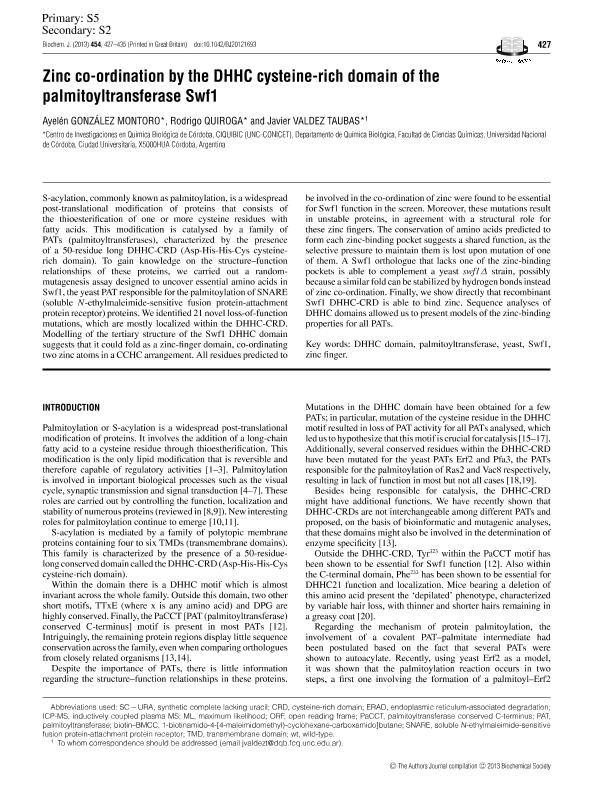Mostrar el registro sencillo del ítem
dc.contributor.author
González Montoro, María Ayelén

dc.contributor.author
Quiroga, Rodrigo

dc.contributor.author
Valdez, Javier Esteban

dc.date.available
2017-10-04T19:27:27Z
dc.date.issued
2013-09
dc.identifier.citation
González Montoro, María Ayelén; Quiroga, Rodrigo; Valdez, Javier Esteban; Zinc co-ordination by the DHHC cysteine-rich domain of the palmitoyltransferase Swf1; Portland Press; Biochemical Journal; 454; 3; 9-2013; 427-435
dc.identifier.issn
0264-6021
dc.identifier.uri
http://hdl.handle.net/11336/25900
dc.description.abstract
S-acylation, commonly known as palmitoylation, is a widespread post-translational modification of proteins that consists of the thioesterification of one or more cysteine residues with fatty acids. This modification is catalysed by a family of PATs (palmitoyltransferases), characterized by the presence of a 50-residue long DHHC-CRD (Asp-His-His-Cys cysteinerich domain). To gain knowledge on the structure–function relationships of these proteins, we carried out a randommutagenesis assay designed to uncover essential amino acids in Swf1, the yeast PAT responsible for the palmitoylation of SNARE (soluble N-ethylmaleimide-sensitive fusion protein-attachment protein receptor) proteins. We identified 21 novel loss-of-function mutations, which are mostly localized within the DHHC-CRD. Modelling of the tertiary structure of the Swf1 DHHC domain suggests that it could fold as a zinc-finger domain, co-ordinating two zinc atoms in a CCHC arrangement. All residues predicted to be involved in the co-ordination of zinc were found to be essential for Swf1 function in the screen. Moreover, these mutations result in unstable proteins, in agreement with a structural role for these zinc fingers. The conservation of amino acids predicted to form each zinc-binding pocket suggests a shared function, as the selective pressure to maintain them is lost upon mutation of one of them. A Swf1 orthologue that lacks one of the zinc-binding pockets is able to complement a yeast swf1Δ strain, possibly because a similar fold can be stabilized by hydrogen bonds instead of zinc co-ordination. Finally, we show directly that recombinant Swf1 DHHC-CRD is able to bind zinc. Sequence analyses of DHHC domains allowed us to present models of the zinc-binding properties for all PATs.
dc.format
application/pdf
dc.language.iso
eng
dc.publisher
Portland Press

dc.rights
info:eu-repo/semantics/openAccess
dc.rights.uri
https://creativecommons.org/licenses/by-nc-sa/2.5/ar/
dc.subject
S-Acylation
dc.subject
Protein
dc.subject
Dhcc Domain
dc.subject
Zinc Coordination
dc.subject.classification
Bioquímica y Biología Molecular

dc.subject.classification
Ciencias Biológicas

dc.subject.classification
CIENCIAS NATURALES Y EXACTAS

dc.title
Zinc co-ordination by the DHHC cysteine-rich domain of the palmitoyltransferase Swf1
dc.type
info:eu-repo/semantics/article
dc.type
info:ar-repo/semantics/artículo
dc.type
info:eu-repo/semantics/publishedVersion
dc.date.updated
2017-10-03T18:22:55Z
dc.journal.volume
454
dc.journal.number
3
dc.journal.pagination
427-435
dc.journal.pais
Reino Unido

dc.journal.ciudad
Londres
dc.description.fil
Fil: González Montoro, María Ayelén. Consejo Nacional de Investigaciones Científicas y Técnicas. Centro Científico Tecnológico Conicet - Córdoba. Centro de Investigaciones en Química Biológica de Córdoba. Universidad Nacional de Córdoba. Facultad de Ciencias Químicas. Centro de Investigaciones en Química Biológica de Córdoba; Argentina
dc.description.fil
Fil: Quiroga, Rodrigo. Consejo Nacional de Investigaciones Científicas y Técnicas. Centro Científico Tecnológico Conicet - Córdoba. Centro de Investigaciones en Química Biológica de Córdoba. Universidad Nacional de Córdoba. Facultad de Ciencias Químicas. Centro de Investigaciones en Química Biológica de Córdoba; Argentina
dc.description.fil
Fil: Valdez, Javier Esteban. Consejo Nacional de Investigaciones Científicas y Técnicas. Centro Científico Tecnológico Conicet - Córdoba. Centro de Investigaciones en Química Biológica de Córdoba. Universidad Nacional de Córdoba. Facultad de Ciencias Químicas. Centro de Investigaciones en Química Biológica de Córdoba; Argentina
dc.journal.title
Biochemical Journal

dc.relation.alternativeid
info:eu-repo/semantics/altIdentifier/doi/http://dx.doi.org/10.1042/BJ20121693
dc.relation.alternativeid
info:eu-repo/semantics/altIdentifier/url/http://www.biochemj.org/content/454/3/427
Archivos asociados
